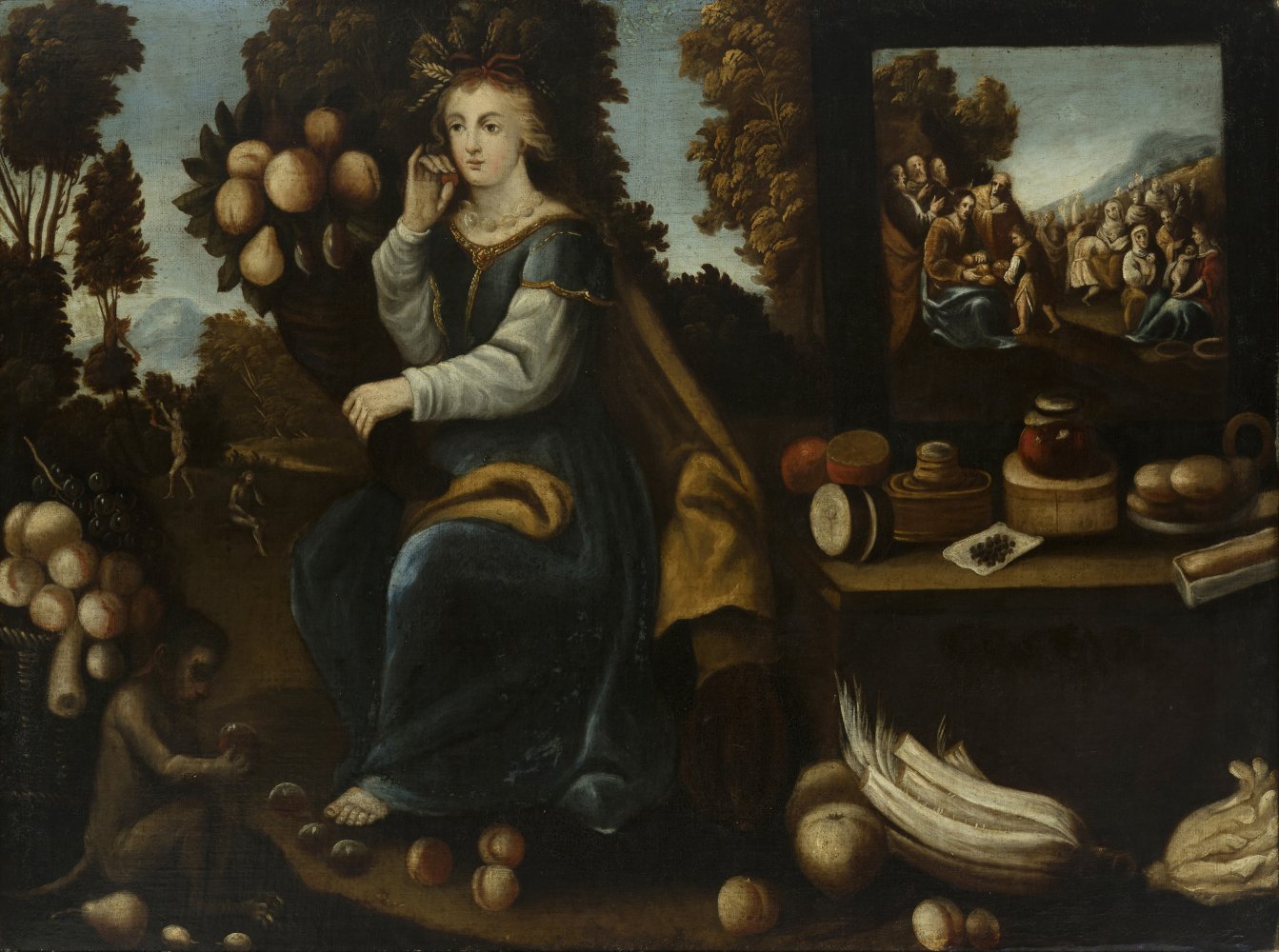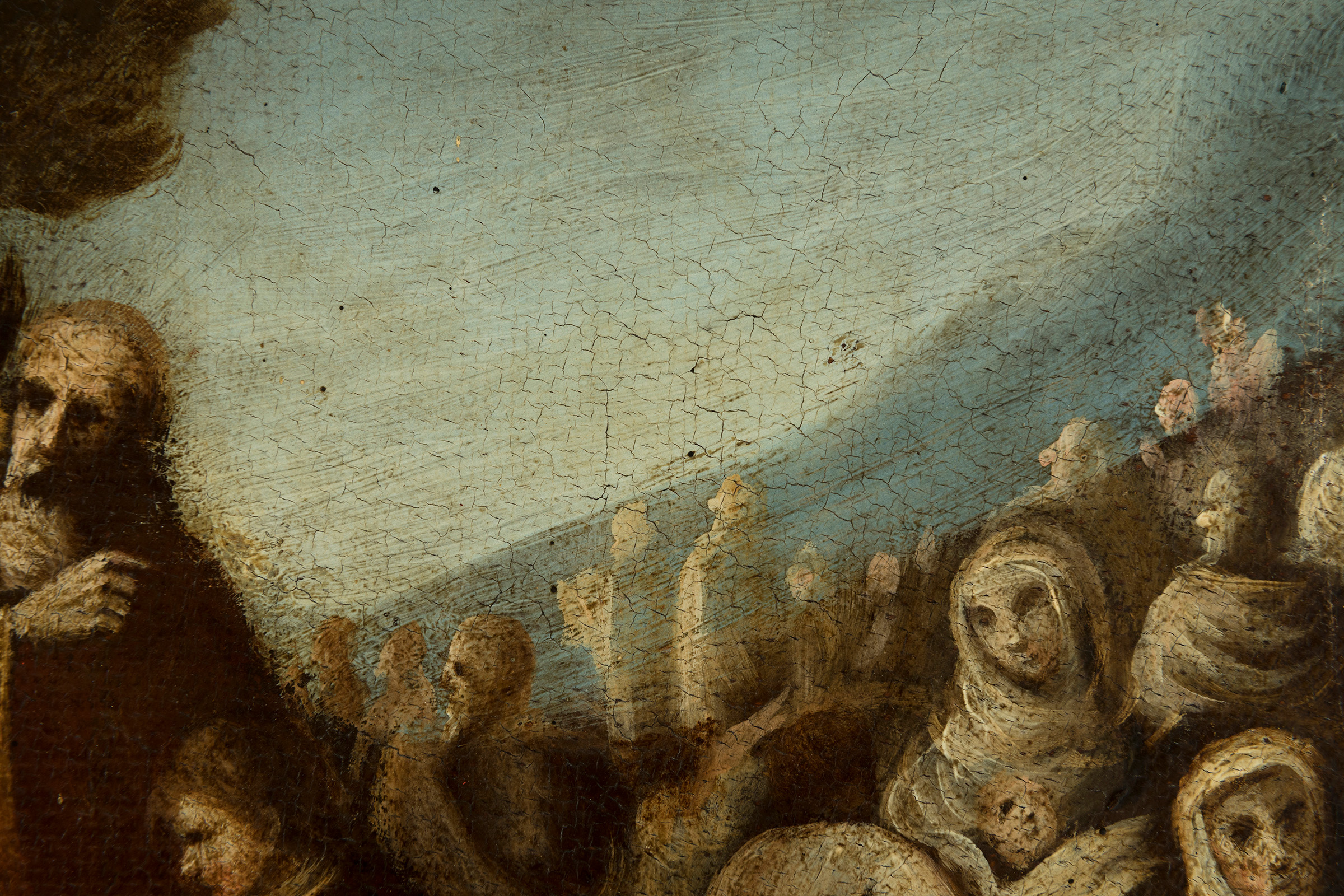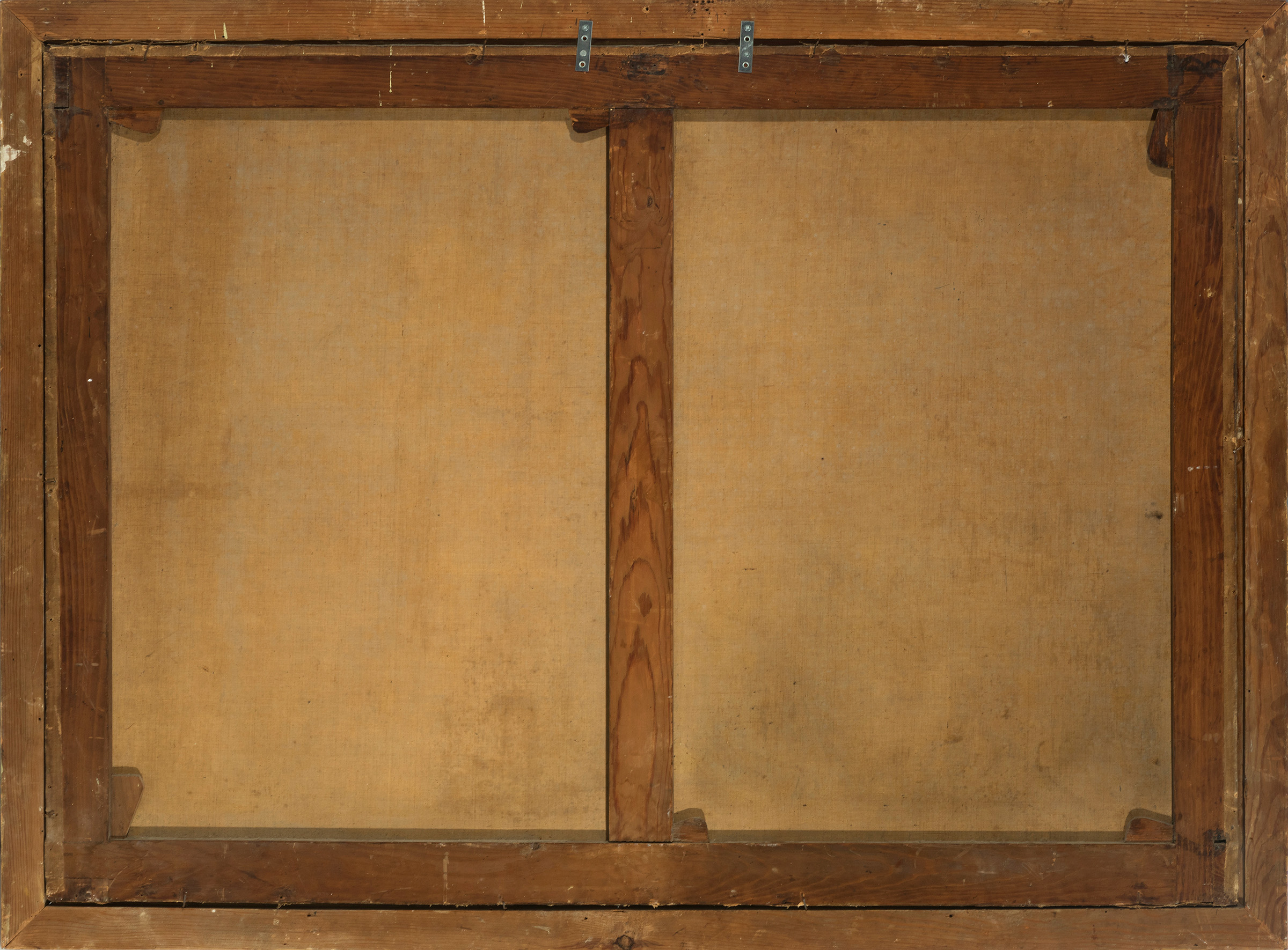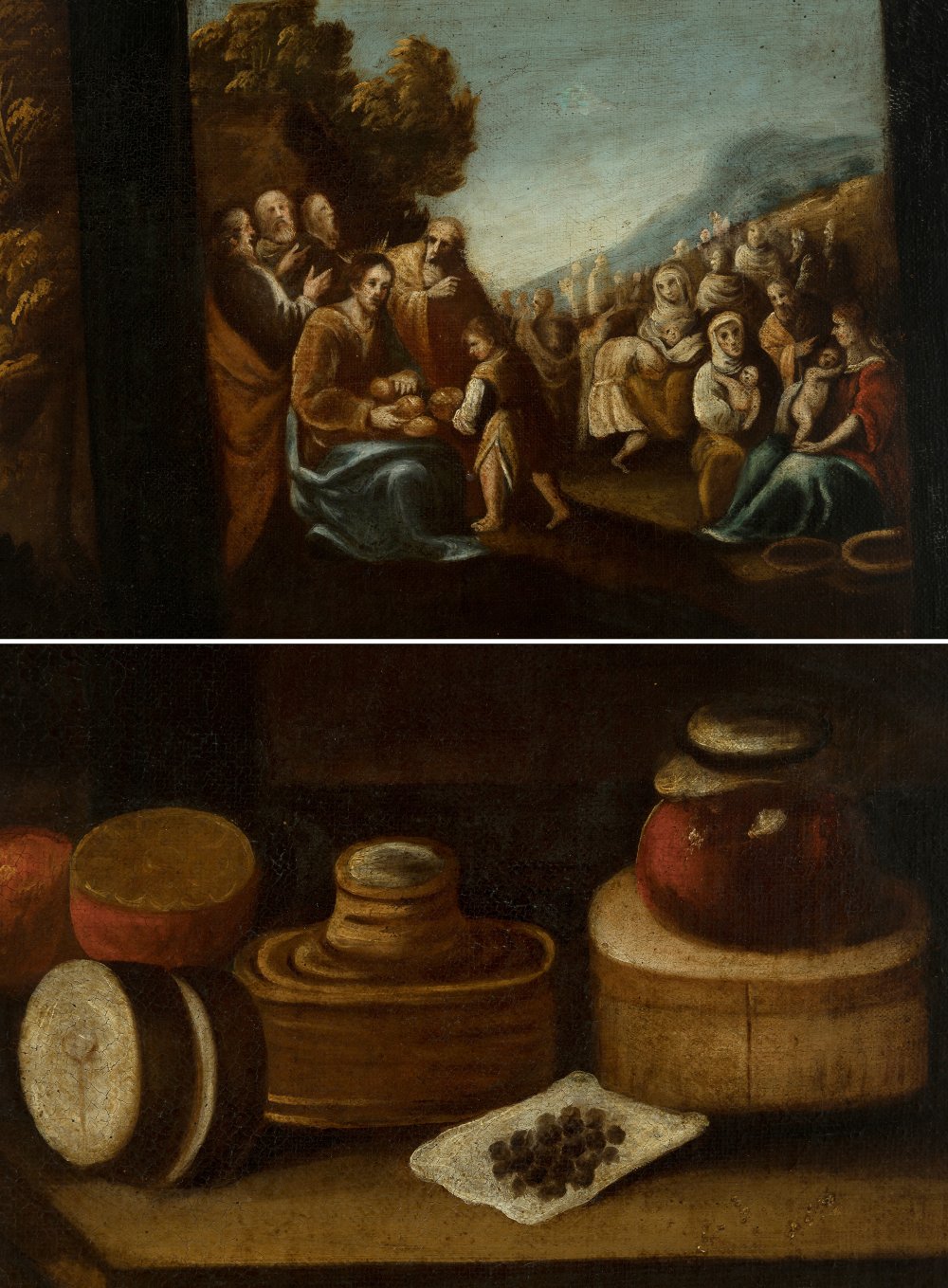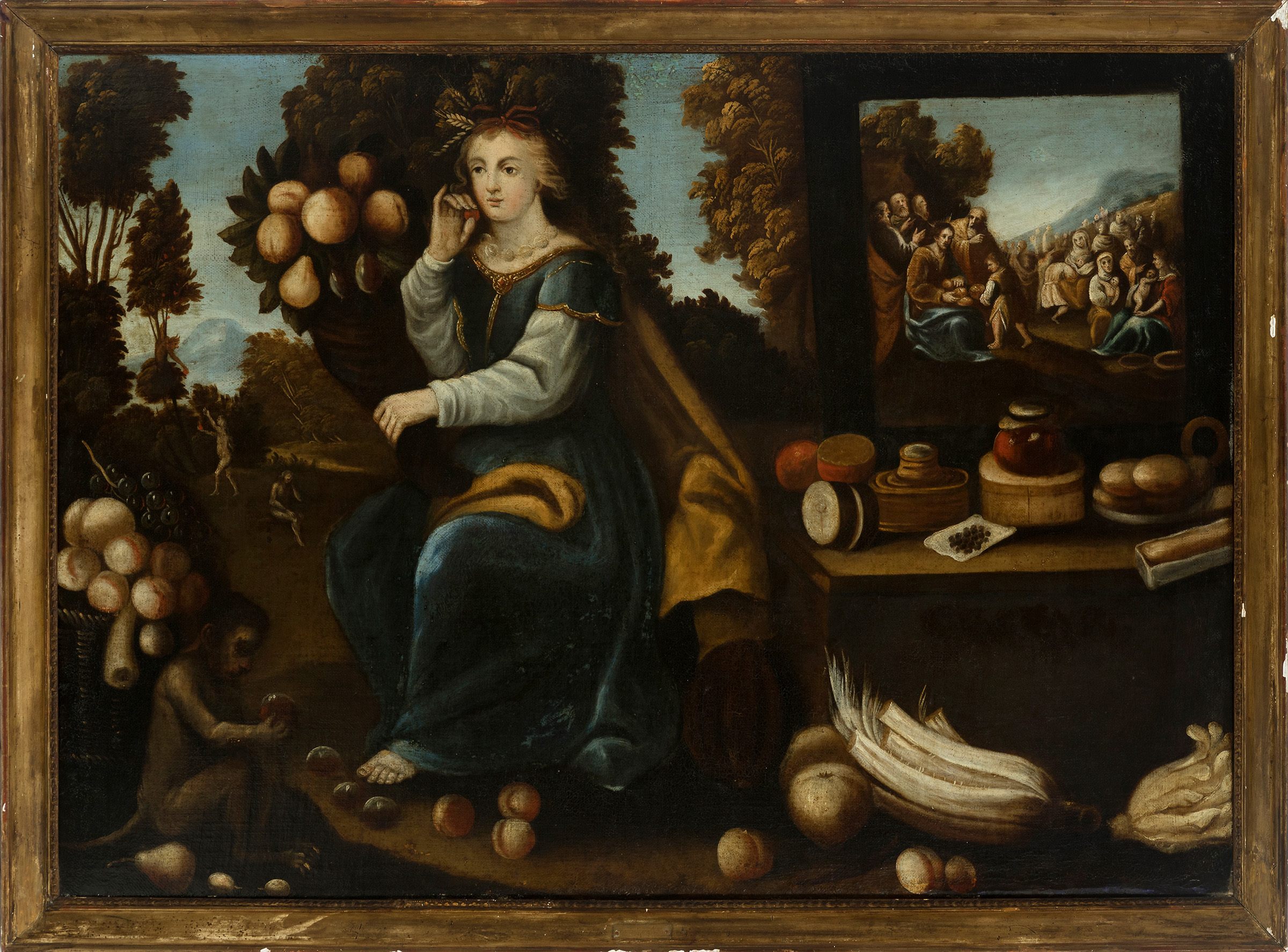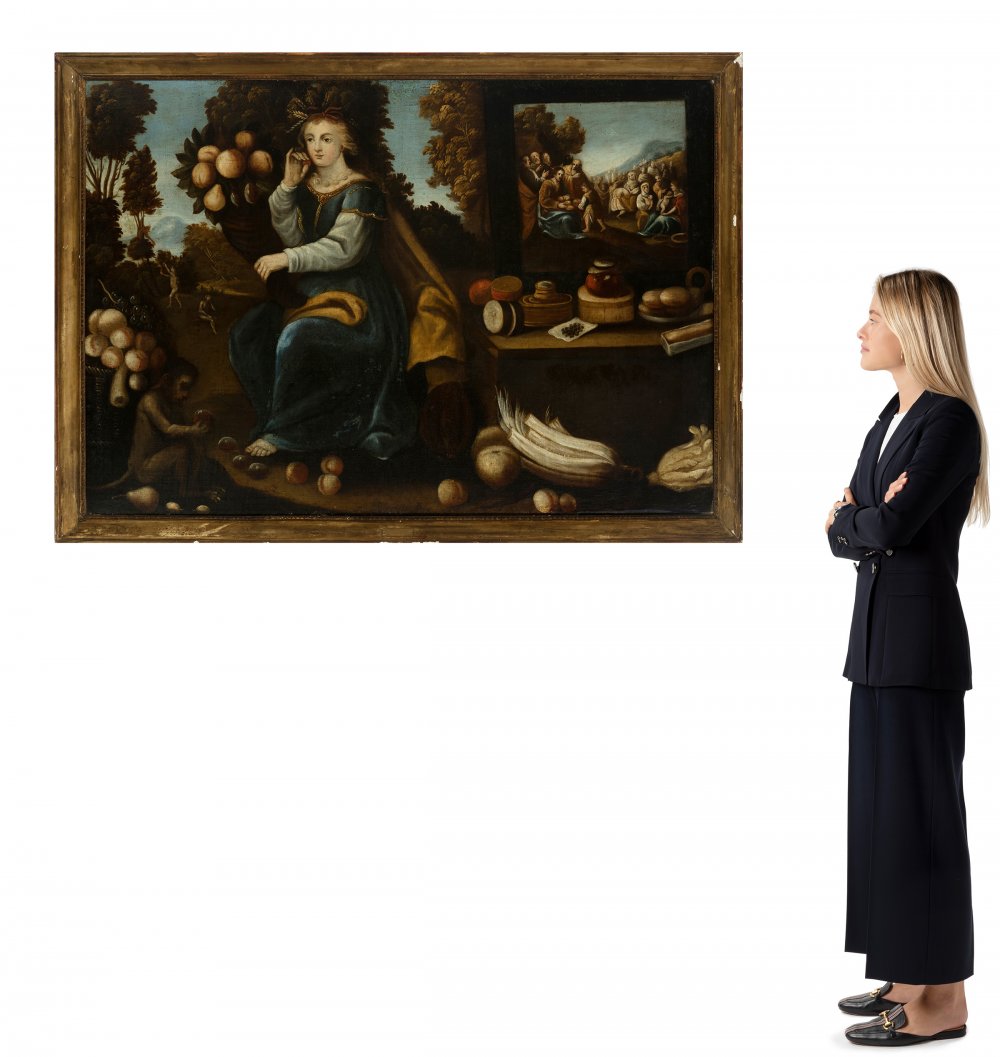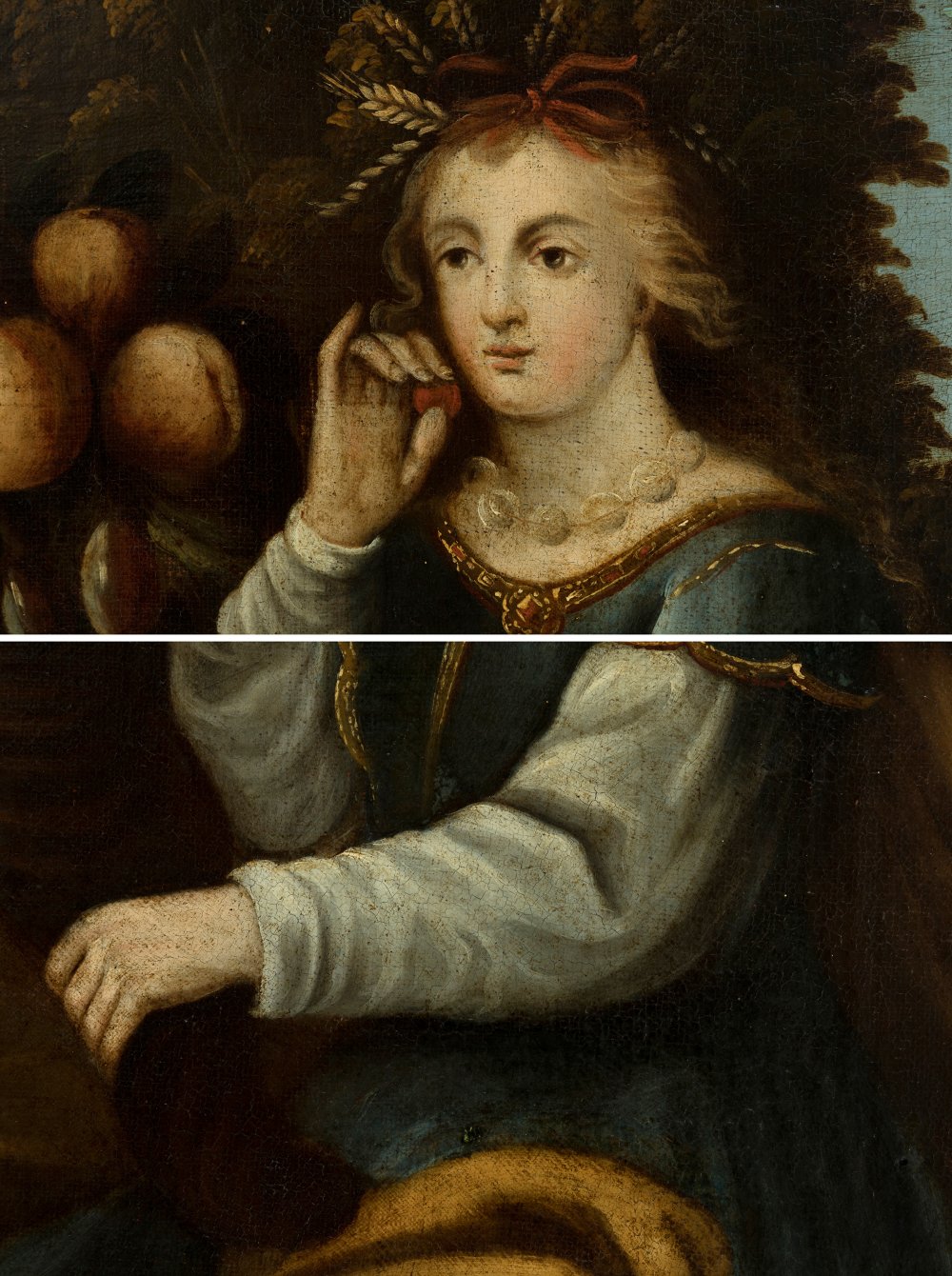6
Circle of FRANCISCO BARRERA (Madrid, 1595 - 1658)."Allegory of Taste".Oil on canvas.Retouching.
1/7
Description
Circle of FRANCISCO BARRERA (Madrid, 1595 - 1658).
"Allegory of Taste".
Oil on canvas.
Retouching.
Restorations.
Frame of the 19th century, with faults.
Measurements: 98,5 x 136 cm; 110 x 148,5 cm (frame).
This is a painting of great iconographic richness, compositional audacity and masterly treatment of the glazes. It belongs to the circle of the Madrid-born Francisco Barrera, a renowned early Baroque still-life painter. His seasonal allegories are very similar in theme and treatment to the present painting. The Flemish school of the time also influenced this painting, which can be related to the oil painting The Taste, a collaborative work by Rubens and Brueghel the Elder. In our painting, the young woman dressed in lapis lazuli blue who is about to eat a piece of fruit embodies the allegory of taste. A necklace of translucent stones adorns her neck. She is surrounded by fruit trees, and on her left a still life of various delicacies is accompanied by a canvas depicting the biblical miracle of the multiplication of the loaves. This typically Baroque device (the painting within the painting) iconographically links the two landscapes (the one occupied by the allegorical figure and the one painted in the biblical painting), thus enlarging and enriching the pictorial surface. The human groups, the villagers gathered around Jesus, have been depicted with great skill. In addition, next to the allegorical figure, the expulsion from paradise has been represented (Adam and Eve, minimised with respect to the female Allegory, have been tempted to eat the apple). In iconographic opposition to both Gospel themes, we see a monkey in the left-hand corner of the painting, symbolising gluttony and earthly pleasures.
The desire to integrate a moral teaching with the still-life theme and the religious theme was widely explored by Francisco Barrera and the Madrid Baroque school, itself heavily influenced by the Flemish school. The idealised features of the young woman, in contrast to the veristic approach in the depiction of the delicacies, reflect a language very close to Barrera's. Barrera's still lifes can also be compared to those of Juan de Van der Hamen, although he moved away from the courtly tone of his master in favour of more intuitive, natural compositions. Particularly famous were his seasonal still lifes with seasonal foodstuffs, which became fashionable at court. Barrera represents a more advanced moment in the Baroque than Van der Hamen and Cotán: he sought asymmetry in his compositions, naturalism in the arrangement of the elements, as well as the importance he gave to the landscape. Francisco Barrera is represented in the Museum of Fine Arts in Seville, the National Museum of Slovakia, and important collections around the world, both public and private.
"Allegory of Taste".
Oil on canvas.
Retouching.
Restorations.
Frame of the 19th century, with faults.
Measurements: 98,5 x 136 cm; 110 x 148,5 cm (frame).
This is a painting of great iconographic richness, compositional audacity and masterly treatment of the glazes. It belongs to the circle of the Madrid-born Francisco Barrera, a renowned early Baroque still-life painter. His seasonal allegories are very similar in theme and treatment to the present painting. The Flemish school of the time also influenced this painting, which can be related to the oil painting The Taste, a collaborative work by Rubens and Brueghel the Elder. In our painting, the young woman dressed in lapis lazuli blue who is about to eat a piece of fruit embodies the allegory of taste. A necklace of translucent stones adorns her neck. She is surrounded by fruit trees, and on her left a still life of various delicacies is accompanied by a canvas depicting the biblical miracle of the multiplication of the loaves. This typically Baroque device (the painting within the painting) iconographically links the two landscapes (the one occupied by the allegorical figure and the one painted in the biblical painting), thus enlarging and enriching the pictorial surface. The human groups, the villagers gathered around Jesus, have been depicted with great skill. In addition, next to the allegorical figure, the expulsion from paradise has been represented (Adam and Eve, minimised with respect to the female Allegory, have been tempted to eat the apple). In iconographic opposition to both Gospel themes, we see a monkey in the left-hand corner of the painting, symbolising gluttony and earthly pleasures.
The desire to integrate a moral teaching with the still-life theme and the religious theme was widely explored by Francisco Barrera and the Madrid Baroque school, itself heavily influenced by the Flemish school. The idealised features of the young woman, in contrast to the veristic approach in the depiction of the delicacies, reflect a language very close to Barrera's. Barrera's still lifes can also be compared to those of Juan de Van der Hamen, although he moved away from the courtly tone of his master in favour of more intuitive, natural compositions. Particularly famous were his seasonal still lifes with seasonal foodstuffs, which became fashionable at court. Barrera represents a more advanced moment in the Baroque than Van der Hamen and Cotán: he sought asymmetry in his compositions, naturalism in the arrangement of the elements, as well as the importance he gave to the landscape. Francisco Barrera is represented in the Museum of Fine Arts in Seville, the National Museum of Slovakia, and important collections around the world, both public and private.
Auction Details
Shipping
T&Cs & Important Info
Ask seller a question
Circle of FRANCISCO BARRERA (Madrid, 1595 - 1658).
"Allegory of Taste".
Oil on canvas.
Retouching.
Restorations.
Frame of the 19th century, with faults.
Measurements: 98,5 x 136 cm; 110 x 148,5 cm (frame).
This is a painting of great iconographic richness, compositional audacity and masterly treatment of the glazes. It belongs to the circle of the Madrid-born Francisco Barrera, a renowned early Baroque still-life painter. His seasonal allegories are very similar in theme and treatment to the present painting. The Flemish school of the time also influenced this painting, which can be related to the oil painting The Taste, a collaborative work by Rubens and Brueghel the Elder. In our painting, the young woman dressed in lapis lazuli blue who is about to eat a piece of fruit embodies the allegory of taste. A necklace of translucent stones adorns her neck. She is surrounded by fruit trees, and on her left a still life of various delicacies is accompanied by a canvas depicting the biblical miracle of the multiplication of the loaves. This typically Baroque device (the painting within the painting) iconographically links the two landscapes (the one occupied by the allegorical figure and the one painted in the biblical painting), thus enlarging and enriching the pictorial surface. The human groups, the villagers gathered around Jesus, have been depicted with great skill. In addition, next to the allegorical figure, the expulsion from paradise has been represented (Adam and Eve, minimised with respect to the female Allegory, have been tempted to eat the apple). In iconographic opposition to both Gospel themes, we see a monkey in the left-hand corner of the painting, symbolising gluttony and earthly pleasures.
The desire to integrate a moral teaching with the still-life theme and the religious theme was widely explored by Francisco Barrera and the Madrid Baroque school, itself heavily influenced by the Flemish school. The idealised features of the young woman, in contrast to the veristic approach in the depiction of the delicacies, reflect a language very close to Barrera's. Barrera's still lifes can also be compared to those of Juan de Van der Hamen, although he moved away from the courtly tone of his master in favour of more intuitive, natural compositions. Particularly famous were his seasonal still lifes with seasonal foodstuffs, which became fashionable at court. Barrera represents a more advanced moment in the Baroque than Van der Hamen and Cotán: he sought asymmetry in his compositions, naturalism in the arrangement of the elements, as well as the importance he gave to the landscape. Francisco Barrera is represented in the Museum of Fine Arts in Seville, the National Museum of Slovakia, and important collections around the world, both public and private.
"Allegory of Taste".
Oil on canvas.
Retouching.
Restorations.
Frame of the 19th century, with faults.
Measurements: 98,5 x 136 cm; 110 x 148,5 cm (frame).
This is a painting of great iconographic richness, compositional audacity and masterly treatment of the glazes. It belongs to the circle of the Madrid-born Francisco Barrera, a renowned early Baroque still-life painter. His seasonal allegories are very similar in theme and treatment to the present painting. The Flemish school of the time also influenced this painting, which can be related to the oil painting The Taste, a collaborative work by Rubens and Brueghel the Elder. In our painting, the young woman dressed in lapis lazuli blue who is about to eat a piece of fruit embodies the allegory of taste. A necklace of translucent stones adorns her neck. She is surrounded by fruit trees, and on her left a still life of various delicacies is accompanied by a canvas depicting the biblical miracle of the multiplication of the loaves. This typically Baroque device (the painting within the painting) iconographically links the two landscapes (the one occupied by the allegorical figure and the one painted in the biblical painting), thus enlarging and enriching the pictorial surface. The human groups, the villagers gathered around Jesus, have been depicted with great skill. In addition, next to the allegorical figure, the expulsion from paradise has been represented (Adam and Eve, minimised with respect to the female Allegory, have been tempted to eat the apple). In iconographic opposition to both Gospel themes, we see a monkey in the left-hand corner of the painting, symbolising gluttony and earthly pleasures.
The desire to integrate a moral teaching with the still-life theme and the religious theme was widely explored by Francisco Barrera and the Madrid Baroque school, itself heavily influenced by the Flemish school. The idealised features of the young woman, in contrast to the veristic approach in the depiction of the delicacies, reflect a language very close to Barrera's. Barrera's still lifes can also be compared to those of Juan de Van der Hamen, although he moved away from the courtly tone of his master in favour of more intuitive, natural compositions. Particularly famous were his seasonal still lifes with seasonal foodstuffs, which became fashionable at court. Barrera represents a more advanced moment in the Baroque than Van der Hamen and Cotán: he sought asymmetry in his compositions, naturalism in the arrangement of the elements, as well as the importance he gave to the landscape. Francisco Barrera is represented in the Museum of Fine Arts in Seville, the National Museum of Slovakia, and important collections around the world, both public and private.
29th December - Old Masters
Sale Date(s)
Venue Address
Aragón 346, Barcelona
Calle Velázquez 7, Madrid
Carrer de Cirilo Amorós 55, Valencia
Barcelona
08009
Spain
General delivery information available from the auctioneer
Setdart offers Worldwide shipping
PICK UP IN ROOM: You can come and pick up your lots in our offices (Barcelona, Madrid or Valencia). At the moment of the withdrawal, you will be able to accept the current conditions of the lot by means of a document that you will sign.
YOU CAN SEND ANOTHER PERSON TO PICK UP: This person must present a signed authorization that you can find in our web page by accessing from BUY AT SETDART- LOGISTICS-DOWNLOAD AUTHORIZATION DOCUMENT. You can also send an e-mail with the requested data in AUTHORIZATION DOCUMENT to admin@setdart.com
Important Information
25% buyer´s premium
21% buyer´s premium at www.setdart.com















